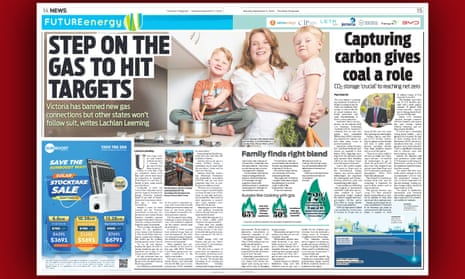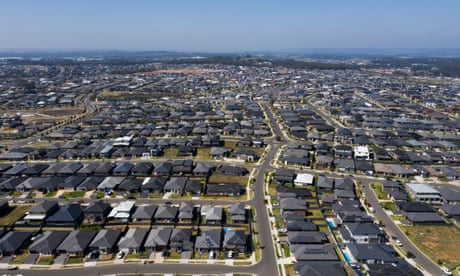Extract from The Guardian

In a double-page spread in News Corp Australia’s metropolitan newspapers on Monday, readers were told how families loved cooking with gas, how gas had been officially stamped as “green” by the European Union and how coal had a future thanks to carbon capture and storage.
The news articles, packed with industry talking points about the future of fossil fuels, were written around a picture of a smiling mum with her two young sons, one of them sitting cross-legged on a kitchen bench next to a gas stove.
Nowhere were readers told the articles – part of a series running this week called Future Energy – were sponsored by seven organisations that included a gas retailer, a gas pipeline company and a project of the black coal industry.

Only a banner in the top right hand corner of the page with a string of logos – including the South Australian government – suggested there might be something unconventional going on.
News Corp confirmed the series was being sponsored but said none of the organisations had any influence over the content, even though many of the sponsors have featured in the stories.
The main article promoted the use of gas appliances in homes and the views of various gas industry figures about how important the fuel they sold would be in the future. The concept of “renewable gas” was also explored.
But at times, the article badly conflated the use of gas in homes for cooking or heating with the role gas is expected to play in electricity generation.
For example, the article said: “Gas will form a critical plank in the road to renewable energy, with most states and the federal government ruling out bans on new home connections despite an assault by Victoria and some councils.”
The first part of this sentence is true in the context of electricity generation. There is wide agreement among energy analysts that gas-fired generators will be needed on standby in the future to provide back-up for solar, wind, hydro and batteries.
But this is different from burning a fossil fuel in your home to cook or stay warm. The health concerns or the climate impacts were not discussed.
Gas is green?
The article claimed the European Union had designated gas a “green energy” last year. Is that true?
The European Union has issued legal guidelines – known as the “sustainable finance taxonomy” – on what constitutes a sustainable investment.
This new taxonomy did not designate “gas a green energy”, but did say that some gas-fired power plants could fall into the category of a sustainable investment – a move not without controversy. The ruling did not relate to burning gas in homes.
But the technical requirements for gas-fired power plants to qualify as a sustainable investment are long and highly restrictive.
The Australian Sustainable Finance Institute told Temperature Check that it was “incorrect” to say the European Union had designated gas as green.
Pointing to the details, the institute said only power plants that emit a maximum of 270g of CO2-equivalent per kilowatt hour of electricity generated, or alternatively an average of 550g of CO2-e/kW of the plant’s capacity over 20 years, could qualify.
For gas power plants to be eligible for sustainable investment, a national coal phase-out plan also needs to be in place, the plant has to be a replacement for coal or other high-emitting fuel source and the generators have to commit to switching to low-carbon fuels by 2035 and prove renewable energy could not do the same job.
If the emissions standard was applied in Australia, many of the country’s gas-fired power plants would not qualify.
That’s all very different from the EU giving gas a green stamp of approval.
Coal capture
In a separate story under the headline “Capturing carbon gives coal a role” readers were told about carbon capture and storage (CCS) technologies that could “capture carbon dioxide and store it safely underground, including directly from large emission sources such as coal-fired power plants”.
The same article later said there were currently 29 CCS facilities globally “with a total capture capacity of almost 40m tonnes [of CO2] annually”.
For context, if those projects did sequester 40m tonnes (and many do not operate close to their capacity) this would be about 0.1% of the 36.6bn tonnes of CO2 released from fossil fuel burning last year.
What the article did not say was that most of those 29 operating CCS facilities are capturing CO2 as part of a process called “Enhanced Oil Recovery” where the CO2 is pumped into oil and gas wells to push out more fossil fuels.
And how many of those 29 CCS facilities (actually, there are 30) are attached to a coal-fired power station?
Just one, according to the latest annual report from the Global CCS Institute. But that facility – at SaskPower’s Boundary Dam coal plant in Canada – has been dogged by issues.
In 2021, the plant captured less than half of its notional 1m tonnes a year capacity.
And what happens to most of the CO2 captured at Boundary Dam? It is sold to local oilfields so that more oil can be extracted.
Do we need to say what’s released when the oil is burned?
Net Zero Australia
Discussing CCS technology as a way to reduce emissions from fossil plants, the story pointed to a major modelling report from the universities of Melbourne, Princeton and Queensland.
But Net Zero Australia report co-author, associate professor Simon Smart, told Temperature Check the report’s recommendations for CCS did not relate to capturing carbon at fossil fuel electricity generators.
He said in all the project’s five modelled scenarios, CCS on coal-fired power stations was never part of the lowest cost energy mix. CCS on gas turbines only played a small role in one scenario, he said, where renewable energy is severely held back.
Sponsored content
Displayed in the top right hand corner of the articles were the logos of electricity and gas retailer Alinta Energy, the coal industry’s Low Emission Technology Australia (LETA), gas network provider Jemena, energy investor Copenhagen Infrastructure Partners, electricity network Transgrid, Chinese electric vehicle maker BYD, and the South Australian government.
Printed in newspapers in Sydney, Brisbane, Gold Coast, Melbourne, Adelaide and Hobart, there were no words saying why the logos were displayed.
News Corp Australia told Temperature Check the organisations were “commercial supporters” of the series that “highlights the importance of Australia’s future energy needs”.
The organisations had “no role in determining, influencing or dictating editorial content”, a News Corp Australia statement said.
Jemena, Alinta Energy and LETA were all featured in the articles.
A statement from the South Australian Department of Energy and Mining said the government was “a sponsor of News Corp Australia’s Future Energy series”.
The department refused to say how much it had paid to sponsor the series.
The statement said the government had “long been a leader in green energy” and was “pleased to encourage a national conversation around our renewable energy future”.
Alinta Energy said it “should be clear” from advertisements it had also taken out in News Corp papers that it was a major partner in the series.
A company spokesperson said it had taken inquiries from journalists writing for the series in the same way it would from any other media, and had no influence or control over the stories.
Drop the petrol
Australia’s powerful lobby group for the oil and gas industry, the Australian Petroleum Production & Exploration Association, has launched a rebrand and dropped the word petroleum from its title.
Appea will now be known as Australian Energy Producers. But as the lobby group’s new website says, its members “produce around 95% of Australia’s oil and gas”.


No comments:
Post a Comment